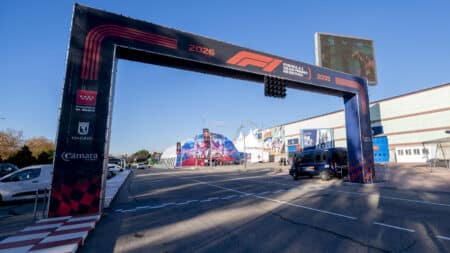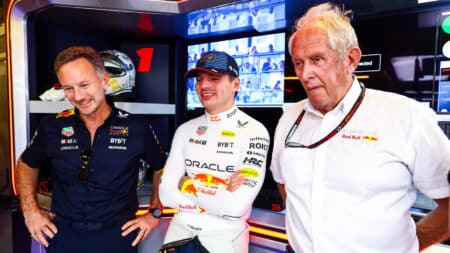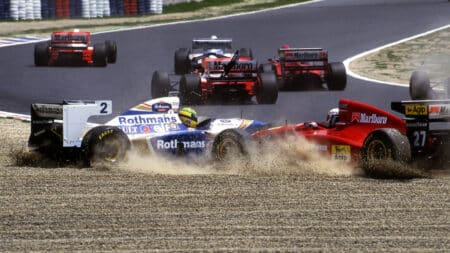
Why isn't 2025 F1 season as close as predicted? The past explains why
McLaren's breakthrough in a near-four-year-old ruleset shows F1 rules convergence is a myth – just like Sebastian Vettel, Red Bull and Renault did in 2013, writes Mark Hughes
What a qualifying session! Massa, having set a quick time early on in Q3, failed to improve on it and was nudged down to P2 when none other than Alonso, at his home grand prix, came through with the clock on zero, to take pole.

The crowd went mad and you could hear the cheers from around the circuit, but Raikkonen was still on his final flying lap and only a matter of seconds after the Spaniard raised the roofs around Barcelona, the Finn went less than 0.100 of a second faster. If only the race tomorrow is as exciting as the end of Q3 was…

As for the McLarens, well let’s hope they were carrying a large amount of fuel as they could do no better than P5 and 6.
Truilli ended another strong qualifying session with 8th position on the grid and now that he clearly has race pace as well, expect him to finish in the points as long as all goes according to plan.

It does seem that the Ferraris have the speed over their rivals but whether Renault can stay up at the front all day who knows. They must be running a light fuel load and perhaps they saw an opportunity in qualifying to give the Spanish fans something to cheer about?
Either way, it’s great to have another team on the front row, it just seems strange that Alonso’s team-mate, Piquet, is a second slower and down in P10. Alonso is clearly an extremely fast driver but how much of that gap is down to the fuel load and how much is down to driver skill?
Well, we’ll find out exactly how fast everyone is tomorrow when Nigel Roebuck reports on the Spanish Grand Prix.
Qualifying
| Pos | Driver | Team | Q1 | Q2 | Q3 |
|---|---|---|---|---|---|
| 1. | Raikkonen | Ferrari | 1:20.701 | 1:20.784 | 1:21.813 |
| 2. | Alonso | Renault | 1:21.347 | 1:20.804 | 1:21.904 |
| 3. | Massa | Ferrari | 1:21.528 | 1:20.584 | 1:22.058 |
| 4. | Kubica | BMW | 1:21.423 | 1:20.597 | 1:22.065 |
| 5. | Hamilton | McLaren | 1:21.366 | 1;20.825 | 1;22.096 |
| 6. | Kovalainen | McLaren | 1:21.430 | 1:20.817 | 1:22.231 |
| 7. | Webber | Red Bull | 1:21.494 | 1:20.984 | 1:22.429 |
| 8. | Trulli | Toyota | 1:21.158 | 1:20.907 | 1:22.529 |
| 9. | Heidfeld | BMW | 1:21.466 | 1:20.815 | 1:22.542 |
| 10. | Piquet | Renault | 1:21.409 | 1:20.894 | 1:22.699 |
| 11. | Barrichello | Honda | 1:21.548 | 1:21.049 | No time |
| 12. | Nakajima | Williams | 1:21.690 | 1:21.117 | |
| 13. | Button | Honda | 1:21.757 | 1:21.211 | |
| 14. | Glock | Toyota | 1:21.427 | 1:21.230 | |
| 15. | Rosberg | Williams | 1:21.472 | 1:21.349 | |
| 16. | Bourdais | STR | 1:21.540 | 1:21.724 | |
| 17. | Coulthard | Red Bull | 1:21.810 | No time | |
| 18. | Vettel | STR | 1:22.108 | ||
| 19. | Fisichella | F India | 1:22.516 | ||
| 20. | Sutil | F India | 1:23.224 | ||
| 21. | Davidson | S Aguri | 1:23.318 | ||
| 22. | Sato | S Aguri | 1:23.496 |

McLaren's breakthrough in a near-four-year-old ruleset shows F1 rules convergence is a myth – just like Sebastian Vettel, Red Bull and Renault did in 2013, writes Mark Hughes

Madrid finally has a consortium to build the new Formula 1 circuit that will host the 2026 Spanish GP

Helmut Marko caused a stir after the Bahrain GP with his worries that Max Verstappen could leave Red Bull early. But how real are those fears?

Ayrton Senna’s tragic final races in 1994, marked by controversy over illegal traction control and his relentless pursuit of excellence in a challenging car, remain a poignant chapter in F1 history, as Matt Bishop recalls